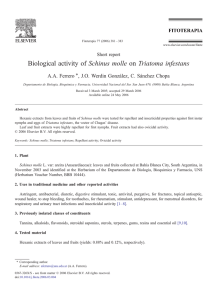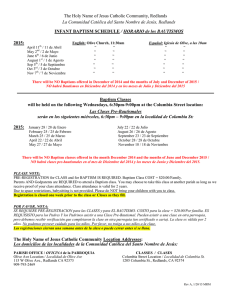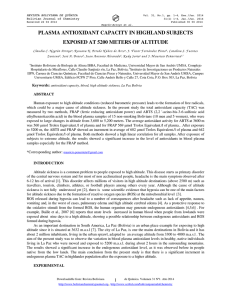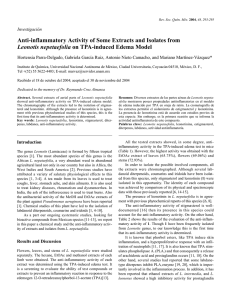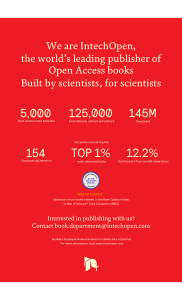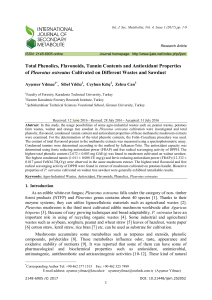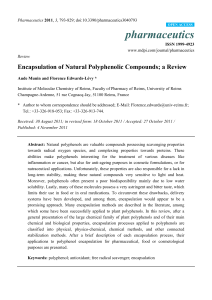Print version - Grasas y Aceites
Anuncio
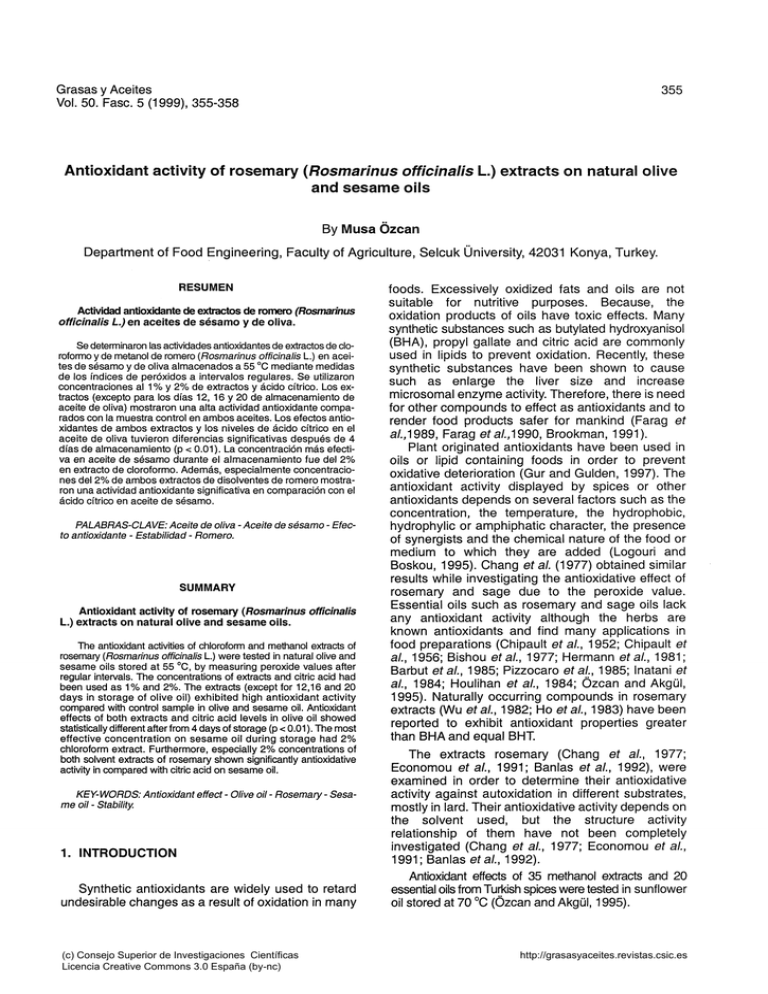
Grasas y Aceites
Vol. 50. Fase. 5 (1999), 355-358
355
Antioxidant activity of rosemary {Rosmarinus officinaiis L.) extracts on natural olive
and sesame oils
By Musa Ôzcan
Department of Food Engineering, Faculty of Agriculture, Selcuk University, 42031 Kenya, Turkey.
RESUMEN
Actividad antioxidante de extractos de romero (Rosmarinus
officinalis L) en aceites de sésamo y de oliva.
Se determinaron las actividades antioxidantes de extractos de cloroformo y de metanol de romero (Rosmarinus officinalis L.) en aceites de sésamo y de oliva almacenados a 55 °C mediante medidas
de los índices de peróxidos a intervalos regulares. Se utilizaron
concentraciones al 1 % y 2% de extractos y ácido cítrico. Los extractos (excepto para los días 12,16 y 20 de almacenamiento de
aceite de oliva) mostraron una alta actividad antioxidante comparados con la muestra control en ambos aceites. Los efectos antioxidantes de ambos extractos y los niveles de ácido cítrico en el
aceite de oliva tuvieron diferencias significativas después de 4
días de almacenamiento (p < 0.01). La concentración más efectiva en aceite de sésamo durante el almacenamiento fue del 2%
en extracto de cloroformo. Además, especialmente concentraciones del 2% de ambos extractos de disolventes de romero mostraron una actividad antioxidante significativa en comparación con el
ácido cítrico en aceite de sésamo.
PALABRAS-CLAVE: Aceite de oliva - Aceite de sésamo - Efecto antioxidante - Estabilidad - Romero.
SUÍVIIVIARY
Antioxidant activity of rosemary {Rosmarinus officinalis
L.) extracts on natural olive and sesame oils.
The antioxidant activities of chloroform and methanol extracts of
rosemary [Rosmarinus officinalis L.) were tested in natural olive and
sesame oils stored at 55 °C, by measuring peroxide values after
regular intervals. The concentrations of extracts and citric acid had
been used as 1% and 2%. The extracts (except for 12,16 and 20
days in storage of olive oil) exhibited high antioxidant activity
compared with control sample in olive and sesame oil. Antioxidant
effects of both extracts and citric acid levels in olive oil showed
statistically different after from 4 days of storage (p < 0.01 ). The most
effective concentration on sesame oil during storage had 2%
chloroform extract. Furthermore, especially 2% concentrations of
both solvent extracts of rosemary shown significantly antioxidative
activity in compared with citric acid on sesame oil.
KEY-WORDS: Antioxidant effect - Olive oil - Rosemary - Sesame oil - Stability.
1. INTRODUCTION
Synthetic antioxidants are widely used to retard
undesirable changes as a result of oxidation in many
(c) Consejo Superior de Investigaciones Científicas
Licencia Creative Commons 3.0 España (by-nc)
foods. Excessively oxidized fats and oils are not
suitable for nutritive purposes. Because, the
oxidation products of oils have toxic effects. Many
synthetic substances such as butylated hydroxyanisol
(BHA), propyl gállate and citric acid are comnnonly
used in lipids to prevent oxidation. Recently, these
synthetic substances have been shown to cause
such as enlarge the liver size and increase
microsomal enzyme activity. Therefore, there is need
for other compounds to effect as antioxidants and to
render food products safer for mankind (Farag et
a/.,1989, Farag eia/.,1990, Brookman, 1991).
Plant originated antioxidants have been used in
oils or lipid containing foods in order to prevent
oxidative deterioration (Gur and Gulden, 1997). The
antioxidant activity displayed by spices or other
antioxidants depends on several factors such as the
concentration, the temperature, the hydrophobic,
hydrophylic or amphiphatic character, the presence
of synergists and the chemical nature of the food or
medium to which they are added (Logouri and
Boskou, 1995). Chang et al. (1977) obtained similar
results while investigating the antioxidative effect of
rosemary and sage due to the peroxide value.
Essential oils such as rosemary and sage oils lack
any antioxidant activity although the herbs are
known antioxidants and find many applications in
food preparations (Chipault et a!., 1952; Chipault et
a!., 1956; Bishou eta!., 1977; Hermann eta!., 1981;
Barbut efa/., 1985; Pizzocaro eta!., 1985; Inatani et
al., 1984; Houlihan et al., 1984; Ózcan and Akgül,
1995). Naturally occurring compounds in rosemary
extracts (Wu etal., 1982; Ho etal., 1983) have been
reported to exhibit antioxidant properties greater
than BHA and equal BHT
The extracts rosemary (Chang et al., 1977;
Economou et al., 1991; Banlas et al., 1992), were
examined in order to determine their antioxidative
activity against autoxidation in different substrates,
mostly in lard. Their antioxidative activity depends on
the solvent used, but the structure activity
relationship of them have not been completely
investigated (Chang et al., 1977; Economou et al.,
1991; Banlas eí a/., 1992).
Antioxidant effects of 35 methanol extracts and 20
essential oils from Turkish spices were tested in sunflower
oil stored at 70 °C (Ózcan and Akgül, 1995).
http://grasasyaceites.revistas.csic.es
356
Thus, the objective of this study was to evaluate
to efficacy of adding a natural rosemary oleoresin to
sesame and olive oils and to compare it with a
commercial citric acid used as an antioxidant.
Grasas y Aceites
Table I
The codes of the extract and citric acid
added samples
Olive oil samples
Ao
Control
Containing 1% (w/w) chloroform extract of rosemary
"
2. MATERIALS AND METHODS
2
1
«
Methanol
2
1
Plant Material and Preparation of Extracts:
Rosemary was purchased from market. Ground
material was extracted with pure methanol and
chloroform for 3 hr in a stirred vessel, at a liquid-to-solid
ratio 4:1 and a temperature of 60 °C. The mixture was
filtered and concentrated in rotary evaporator and
solvent was completely removed. Extracts were kept in
sealed bottles under refrigerated using.
«
Citric Acid: Citric acid (E.Merck, Darmstadt) was
preferred because of using commonly as prevent to
the deterioration at oil company.
Antioxidant Activity Measurement: The rate of
oxidation was followed by periodic determination of
peroxide values of the oil stored at 55 °C by using
chloroform and methanol as extraction solvents
which are at different polarities. A calculated quantity
of the extract and citric acid was added at the 1 and
2% concetrations into olive and sesame oil, and the
mixture was stirred. A control sample was prepared
under the same conditions without adding any
antioxidant. All samples of 20 g each were storaged
in 10 X 100 mm open beakers at 55 °C in the dark.
For the peroxide number, a known weight of olive
and sesame oils (2 g) was dissolved in a mixture of
CH3COOH: CHCI3 (3:2, v/v), and saturated solution
of Kl (1ml) was then added. The liberated iodine was
titrated with sodium thiosulfate solution (0.01 N) in the
presence of starch as an indicator (A.O.C.S., 1989).
The codes of the samples are shown in Table I. It
should be mentioned that in experiments, with the
plant extracts at various concentrations, raw olive
and sesame oils were used.
Statistical Analyses: Findings of*the research
were analysed for statistical significance by analyses
of variance, and differences among groups were
established according to Düzgünes et al. (1987).
Experiments and analysis were replicated and
duplicated.
(c) Consejo Superior de Investigaciones Científicas
Licencia Creative Commons 3.0 España (by-nc)
A3
As
As
Control
Bo
Containing 1 % (w/w) chloroform extract of rosemary
Bi
2
-
1
B2
Methanol
2
1
Bs
B4
citric acid
2
Olive and Sesame Oils: Naturel olive and sesame
oils without adding any antioxidant were kindly supplied
by Kristal and Salur company in Yzmir and Kenya,
respectively. Their peroxide numbers were 15 and 18.1
meq/kg, the same respectively. The sesame oil was
selected for their high degree unsaturation levels and
for being the most widely used as edible and tehina
(sesame paste) oil in Turkey.
A2
A4
citric acid
2
S^ame di samples
Ai
Bs
Be
3. RESULTS AND DISCUSSION
Table II represents the antioxidant effect of the
chloroform and methanol extracts of rosemary, and
citric acid in olive and sesame oils as determined by
the peroxide value.
After 4 days, the extract concentrations showed
antioxidant effect in varying degrees on olive and
sesame oil compaered with the control test (p < 0.01).
Peroxide values of all the samples partly increased
during storage. After 12 days, peroxide values of
sesame oil at all the concentrations had higher than
those of olive oil. At both extract concentrations of
chloroform and methanol peroxide values were high
according to control on 16 and 20 days. But,
antioxidant effects of both solvent extract
concentrations (1%) in olive oil are higher than that
of the same citric acid concentration as from 4,8 and
12 days. But, the same concentrations (1%) of
extracts in sesame oil showed antioxidant effect
according to citric acid (1%) concentration.
The 2% concentration of chloroform and
methanol in sesame oil had more effect than those of
only 2% concentration of chloroform and methanol
extracts and both concentrations of citric acid (p < 0.01 ).
The most effective concentration on sesame oil
during storage had 2% chloroform (Fig.1). Furthermore,
especially 2% levels of both solvent extracts of
rosemary exhibited remarkable antioxidative activity in
comparison with citric acid on sesame oil (p < 0.01).
Overall strongest activity of rosemary was not
surprising, because of various findings reported on
its stabilizing effect (Chang etal., 1977; Braceo et al.,
1981), and related active components such as
carnosol, rosmanol, rosmariquinone, carnosic and
ursolic acids etc. (Wu et al., 1982; Inatani et al.,
1983; Houlihan étal., 1985; Chen étal., 1992).
http://grasasyaceites.revistas.csic.es
Vol.50. Fase. 5(1999)
357
Table II
Antioxidant effect of rosemary extract added to olive and sesame oils* stored in thie darl< at 55 °C (meq/kg)
Chloroform Extract (%)
Days
4
8
Oils
Citric Acid (%)
Methanol Extract (%)
Control
1
2
1
1
2
2
Olive
25.00 ± 0.62K**
23.70 ± 0.63J
19.30 ± 0.64H
24.30 ± 0.29H
24.50 ± 0.321
19.50 ± 1.1 OJ
19.40 ± 0.921
Sesame
51.70 ± 0.32F
49.70 ± 0.87F
23.00 ± 1.15G
21.20 ± 0.181
26.80 ± 0.39H
49.00 ± 0.29E
37.60 ± 0.67E
Olive
28.20 ± 0.52J
30.20 ± 0.761
20.70 ± 1.41 H
25.60 ± 0.55G
30.50 ± 1.77G
25.05 ± 0.731
29.80 ± 0.65H
Sesame
72.10 ± 0.65E
56.70 ± 0.59E
24.30 ± 0.59G
24.90 ± 1.45GH
38.30 ± 0.97E
56.00 ± 0.18D
53.90 ± 0.91 D
Olive
31.70 ± 0.701
34.10 ± 0.54H
32.40 ± 0.42F
33.50 ± 0.66F
31.30 ± 0.84G
27.10 ± 0.42H
31.00 ± 1.13GH
Sesame
98.00 ± 0.39D
65.80 ± 0.29D
34.50 ± 1.20E
44.20 ± 0.39D
45.60 ± 0.59D
57.80 ± 0.55CD
77.80 ± 0.1 OC
Olive
32.80 ± 0.68HÍ
34.50 ± 0.63H
34.30 ± 0.39E
33.90 ± 0.57F
31.40 ± 0.80G
36.20 ± 1.50G
32.50 ± 1.14G
Sesame
104.9Q ± 0.65C
68.80 ± 0.760
48.50 ± 0.84C
49.00 ± 0.38C
49.50 ± 0.65C
58.70 ± 0.79C
79.20 + 0.70BC
Olive
33.50 ± 0.74H
35.60 ± 0.78H
35.00 ± 0.32E
34.30 ± 0.41 F
34.90 ± 1.34F
37.00 ± 0.94G
35.60 + 1.16F
Sesame
106.60 ± 0.39B
76.80 ± 0.85B
51.90 ± 1.28B
52.90 ± 0.47B
54.80 ± 0.41 B
61.10 ± 1.05B
79.70 ± 0.46B
Olive
48.90 ± 0.79G
39.50 ± 1.87G
38.80 ± 0.65D
37.90 ± 0.33E
38.00 ± 1.28E
40.80 ± 0.74F
36.22 ± 0.47EF
Sesame
151.20 ± 0.99A
82.12 ± 1.42A
55.62 ± 0.39A
65.80 ± 0.82A
66.40 ± 0.42A
159.70 ± 2.26A
161.50 ± 0.71 A
12
16
20
24
Initial peroxide value of the olive and sesame oil were 15.0 and 18.1 meq/kg, respectively.
* Differences among means indicated with majuscules are significant in p < 0.01.
days of storage. Peroxide values of sesame oil,
especially 12 days, had higher than those of olive oil
as from 12 days of storage. The reason for this is
probably that initial peroxide value of sesame oil was
higher than that of other oil. However, it was seen
that the antioxidant activity of the extract depends on
the polarity of the solvents used for extraction.
REFERENCES
Figure 1
Changes in peroxide values in sesame oil that rosemary
extract and citric acid
4. CONCLUSIONS
The results indicated that rosemary extract
obtained by different polarities solvents an
antioxidant activity on olive and sesame oils at 55 °C.
Antioxidant effects of both extracts and citric acid
levels in olive oil had found significantly different after
fronn 4 days of storage. However, antioxidant effects
of both extract concentrations of solvents were
silightly weaker than that of control on 16 and 20
(c) Consejo Superior de Investigaciones Científicas
Licencia Creative Commons 3.0 España (by-nc)
A.O.C.S. (1989).—«Official methods and recommended
practices».—Vol. I, 4 th edn., 2 nd print, (including
1990 and 1992 additions and revisions). American Oil
Chemists' Society, Champaign, ILL.
Barbut, S., Josephson, D. B., Maurer, A. J. (1985).—
«Antioxidant properties of rosemary oleoresin in
Turkey sausage».—J. Food Soi., 50,1356-1359,1363.
Banyas, C , Oreopoulou, V., Thomopoulos, C. D. (1992).—
«The effect of primary antioxidants and synergistics on
the activity of plant extracts in lard».— J. Am. Oil
Chem. Soc, 69, 520-524.
Bishov, S. J., Masuoka, Y, Kapsalis, J. G. (1977).—
«Antioxidant effect of spices, herbs and protein
hydrolysates in freeze-dried model systems:
synergistic action with synthetic phenolic antioxidants».—
J. Food Process. Preserv., 1, 153-166.
Braceo, U., Loliger, J., Viret, J. L (1981).—«Production
and use of natural antioxidants».—J. Amer. Oil Chem.
Soc, 58, 686-690.
Brookman, P. (1991).—«Antioxidants and consumer
acceptance».—Food/Pharm.lnd., Roche Products
New Zealand.
Chang, S. S., Ostric-Matijasevic, B., Hsieh, O. A. L, Huang, C.
L. (1977).—«Natural antioxidant from rosemary and
sage».—J. Food Sci., 42, 1102-1106.
http://grasasyaceites.revistas.csic.es
358
Chen, Q., Shi, H., Ho, C. T. (1992).—«Effects of rosemary
extracts and major constituents on lipid oxidation and
soybean lipoxygenase activity».—J. Am. Oil Chem.
Soc, 69, 999-1002.
Chipault, J. R., Mizuno, G. R., Hawkins, J. M., lundberg,
W.O. (1952).—«The antioxidant properties of natural
spices».—Food Res., 17, 46-53.
Chipault, J. R., Mizuno, G. R., Hawkins, J. M. (1956).—
«The antioxidant properties of spices in foods».—Food
Technol., 10, 209-211.
Duzgunet, O., Kesici, T, Kavuncu, O., Gurbuz, F. (1987).—
«Methods of Research and Experiment».—(The
Statistical Methods-ll). Ankara Univ. Agrio. Fac. Publ.
N.° 1021, Ankara, Turkey.(in Turkish)
Economou, K. D., Oreopoulou, V., Thomopoulos, C. D.
(1991).—«Antioxidant activity of some plant extracts of
the family Labiatae».—J. Am. Oil Chem. Soc, 68,
109-113.
Farag, R. S., Badei, A. Z. M. A., El-Baroty, G. S. A. (1989).—
«Influence of thyme and clove essential oils on cotton
seed oil oxidation».—J. Am. Oil Chem. Soc, 66,
800-804.
Farag, R. S., Ali, M. N., Taha, S. H. (1990).—«Use of some
essential oils as natural preservatives for butter».—J.
Am. Oil Chem. Soc, 68,188-191.
Gür, E., Gulden, 0. (1997).—«Oregana (Oreganum onites
L.) ekstraktla^n^ rafine zeytin^aoyndaki antioksidatif
etkilerinin incelenmesi. (Antioxidative activity of
orégano (Oreganum onites L.) extracts in refined olive
oil.)».—GdaTeknolojisi, 7/8, 56-64.(in Turkish)
Hermann, K. (1981).—«Uberdieantioxidativewirkung von
gewurzen».—Dtsch. Lebensm. Rdsch., 76,134-139.
Ho, C.-T, Houlihan, C. M., Chang, S. S. (1983).—
«Structural determination of two antioxidants isolated
(c) Consejo Superior de Investigaciones Científicas
Licencia Creative Commons 3.0 España (by-nc)
Grasas y Aceites
from rosemary».—Abstract of papers presented at the
1 86*" Amer. Chem. Soc Meeting, Washington, DC.
Houlihan, C. M., Ho, C.-T, Chang, S. S. (1984).—
«Elucidation of the chemical structures of a novel
antioxidant,
rosmaridiphenol
isolated
from
rosemary».—JAOCS, 61, 1036.
Houlihan, C. M., Ho, C.-T, Chang, S. S. (1985).—«The
structure of rosmariquinone. Anew antioxidant isolated
from Rosmarinus officinalis L.».—J. Am. Oil Chem.
Soc, 62, 96-98.
Inatani, R., Nakatanl,N., Fuwa,H. (1983).—«Antioxidative
effect of the constituents of rosemary (Rosmarinus
officinalis L.) and their derivatives».—Agrie Biol.
Chem., 47, 521-528.
Lagouri, V., Boskou, D. (1995).—«Screening for
antioxidant activity of essential oils obtained from
spices».—Generation, Analysis and Process Influence
(ed.Charalambous, G.), 869-879, Elsevier Science
B.V., London.
Ozcan, M., Akgul, A. (1995).—«Antioxidant activity of
extracts and essential oils from Turkish spices on
suflower oil».—Acta Aliment., 24,81-90.
Pizzocaro, F., Caffa, F., Gasparoli, A. Fedeli, E. (1985).—
«Capacita antiossidante di alcune erbe aromatiche sul
mascólo e sull' olio di sardina».— Riv.lt.Sost.Grasse,
62,351-356.
Wu, j.W.. Lee, M.-H., Ho, C.-T, Chang, S.S. (1982).—
«Elucidation of the chemical structures of natural
antioxidants isolated from rosemary».—J. Am. Oil
Chem. Soc, 59, 339-345.
Recibido: Junio 1998
Aceptado: Enero 1999
http://grasasyaceites.revistas.csic.es




